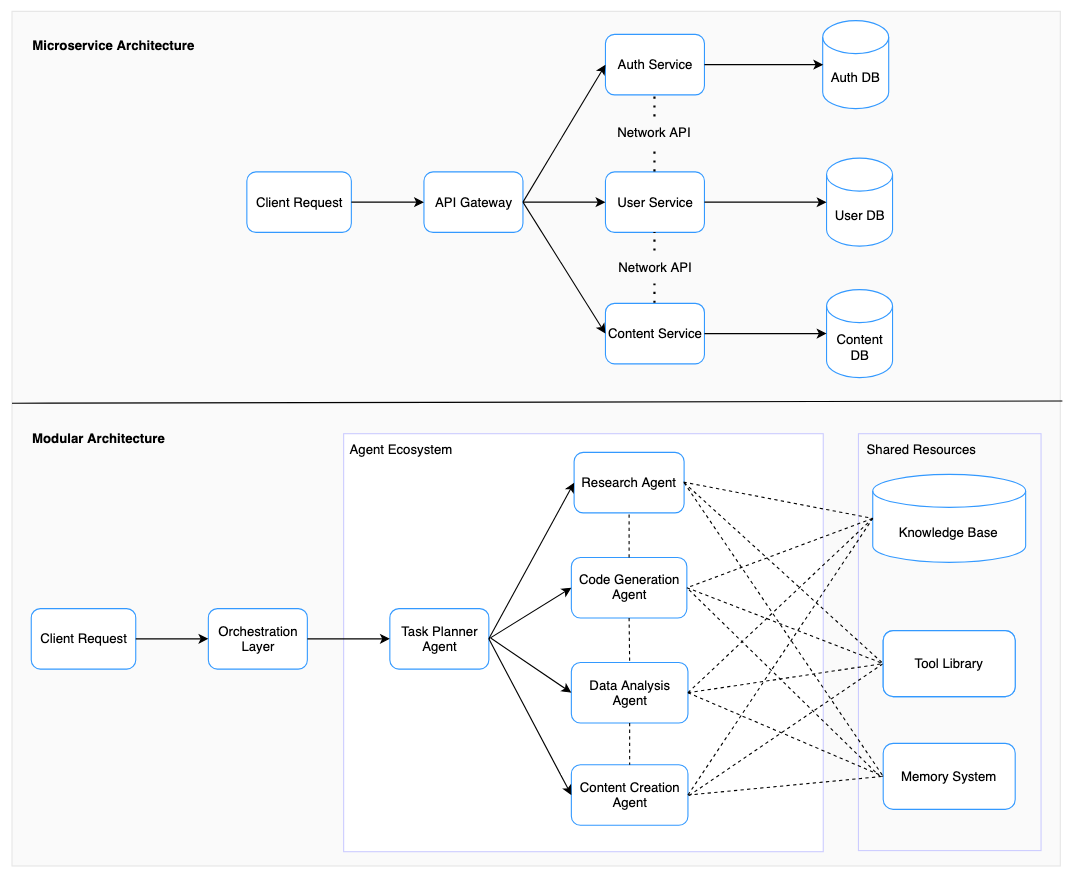The Evolution of Compound AI Systems
A practical comparison between Microservice Architecture and Modular Architecture to make AI more approachable for software engineers.
Software architecture is constantly evolving, and AI systems are reshaping how we think about scalability, efficiency, and design.
While microservices have been the dominant approach for past few years, there's growing interest in modular architecture, especially for AI workloads.
Microservices introduced key advantages:
→ Independently deployable components
→ Technology-agnostic development
→ Isolated data stores
→ API-based communication
But as AI systems scale, some challenges become apparent:
→ Increased network latency
→ Complex inter-service communication
→ High operational overhead
Modular architecture takes a different approach:
→ Logical boundaries instead of strict isolation
→ In-process communication for efficiency
→ Shared resource management
→ Optimized for complex workflows
Key Differences
→ Communication: Microservices rely on network-based API calls, while modular architecture enables more flexible, in-process interactions.
→ Data Management: Microservices often use distributed, service-specific databases, whereas modular systems manage data centrally.
→ Performance: Microservices can introduce latency in cross-service operations, whereas modular designs reduce overhead and improve responsiveness.
As we start building more AI workloads, we realized AI workloads require:
→ Seamless model interactions
→ Low-latency workflows
→ Dynamic component composition
→ Efficient resource utilization
This shift doesn’t mean microservices are obsolete, it’s about choosing the right architecture for the right problem.
AI systems, with their need for fast, interconnected processing, are driving the move toward modularity.
What's your experience with these architectures in your projects? Comment below!
Top Vibe Coding platforms
Coding used to be all about syntax and debugging.
Now, it’s about flow, creativity, and AI-powered tools.
A new wave of "vibe coding" platforms is changing how we build application, where AI collaborates with us instead of just following instructions.
Here are some of the low-code, no-code, and AI-assisted development to help you go from idea to product faster than ever.
Some of my favorites:
Buzzy: Turn Figma designs into working apps.
Lovable: AI-first, drag-and-drop, beautifully designed.
Cursor: AI-powered coding assistant, great for teams.
Retool: The go-to for building internal AI-powered tools.
And for AI workflow automation:
Make: Visual workflow builder with deep AI integrations.
Zapier: Connect AI models to 6,000+ apps with no code.
n8n: Open-source, self-hosted automation for AI-heavy workflows.
These tools don’t just make things faster, they make building feel better.
💡 Have you tried any of these? What’s your go-to for AI-driven development?
Predictive AI vs Generative AI
AI is reshaping trading. But not all AI works the same way.
Predictive AI helps traders:
→ Analyze market trends
→ Forecast price movements
→ Backtest strategies using historical data.
It powers algorithmic trading but relies on past data, which limits its adaptability in unpredictable markets.
Generative AI has changed the game. It generates:
→ Synthetic data for testing
→ Simulates market conditions beyond historical trends
→ Enhances risk assessment.
In short, it helps traders prepare for scenarios predictive models can’t see.
🔹 Predictive AI → Identifies patterns and opportunities
🔹 Generative AI → Stress-tests strategies and simulates market shifts
🔹 Together → More robust, adaptive trading systems
Markets evolve, so, strategies should too and AI makes that possible.
How do you see AI shaping the future of trading? Comment below.


